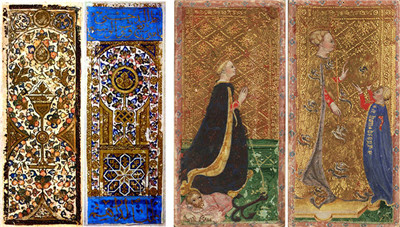Even the earliest known tarot decks weren't designed with mysticism in mind; they were actually meant for playing a game similar to modern-day bridge. Wealthy families in Italy commissioned expensive, artist-made decks known as “carte da trionfi” or “cards of triumph.” These cards were marked with suits of cups, swords, coins, and polo sticks (eventually changed to staves or wands), and courts consisting of a king and two male underlings. Tarot cards later incorporated queens, trumps (the wild cards unique to tarot), and the Fool to this system, for a complete deck that usually totaled 78 cards. Today, the suit cards are commonly called the Minor Arcana, while trump cards are known as the Major Arcana.
即使是最早形式的塔羅牌,也不是按照腦中產生的神秘喻示來設計的,它是一種和現代的橋牌更加類似的游戲。富有的意大利家庭使用昂貴的,名家制作的紙牌,稱作“carte da trionfi”或者說“強手牌”。這些牌上面的標志是杯子,寶劍,錢幣,馬球棍(后來發展成權杖和魔杖),以及由一個國王和兩個隨從組成的法庭。接下來塔羅牌里又在這個系列里加上了皇后,王牌(塔羅牌中一張地位特殊的牌),和愚者,牌的總數發展到了78張。今天,副牌組被稱作小阿卡那,而主牌組被稱作大阿卡那。

Two hand-painted Mamluk cards from Turkey (left) and two cards from the Visconti family deck (right), both circa 15th century.
在土耳其發現的兩張手制的馬木留克牌(左)和兩張來自Visconti家族的紙牌(右),都制作于15世紀。
Graphic designer and artist Bill Wolf, whose interest in tarot illustration dates to his art-school days at Cooper Union in New York, has his own theories about the tarot's beginning. Wolf, who doesn't use cards for divination, believes that originally, “the meaning of the imagery was parallel to the mechanics of the play of the game. The random draw of the cards created a new, unique narrative each and every time the game was played, and the decisions players made influenced the unfolding of that narrative.” Imagine a choose-your-own-adventure style card game.
Bill Wolf是一名繪圖師和藝術家,當年在紐約的庫伯聯盟學院攻讀藝術學位時的興趣就是研究塔羅牌插畫的年代,對于塔羅牌的起源他有另一套理論。作為一個并不用塔羅牌進行占卜的人,他相信,“那些圖畫的意義恰好表現了它們在這個游戲中的玩法,每次隨意畫出的一張新牌,都會在游戲中被賦予新的意義,而古老的玩家對它們的使用又繼續影響了這些意義的變化。”想象中那是一種隨意決定玩法的卡牌游戲。













